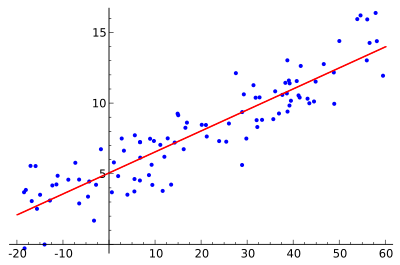General linear model
| Part of a series on Statistics |
| Regression analysis |
|---|
 |
| Models |
| Estimation |
| Background |
|
The general linear model or multivariate regression model is a statistical linear model. It may be written as[1]
where Y is a matrix with series of multivariate measurements (each column being a set of measurements on one of the dependent variables), X is a matrix of observations on independent variables that might be a design matrix (each column being a set of observations on one of the independent variables), B is a matrix containing parameters that are usually to be estimated and U is a matrix containing errors (noise). The errors are usually assumed to be uncorrelated across measurements, and follow a multivariate normal distribution. If the errors do not follow a multivariate normal distribution, generalized linear models may be used to relax assumptions about Y and U.
The general linear model incorporates a number of different statistical models: ANOVA, ANCOVA, MANOVA, MANCOVA, ordinary linear regression, t-test and F-test. The general linear model is a generalization of multiple linear regression model to the case of more than one dependent variable. If Y, B, and U were column vectors, the matrix equation above would represent multiple linear regression.
Hypothesis tests with the general linear model can be made in two ways: multivariate or as several independent univariate tests. In multivariate tests the columns of Y are tested together, whereas in univariate tests the columns of Y are tested independently, i.e., as multiple univariate tests with the same design matrix.
Multiple linear regression
Multiple linear regression is a generalization of simple linear regression to the case of more than one independent variable, and a special case of general linear models, restricted to one dependent variable. The basic model for multiple linear regression is
for each observation i = 1, ... , n.
In the formula above we consider n observations of one dependent variable and p independent variables. Thus, Yi is the ith observation of the dependent variable, Xij is ith observation of the jth independent variable, j = 1, 2, ..., p. The values βj represent parameters to be estimated, and εi is the ith independent identically distributed normal error.
In the more general multivariate linear regression, there is one equation of the above form for each of m > 1 dependent variables that share the same set of explanatory variables and hence are estimated simultaneously with each other:
for all observations indexed as i = 1, ... , n and for all dependent variables indexed as j = 1, ... , m.
Applications
An application of the general linear model appears in the analysis of multiple brain scans in scientific experiments where Y contains data from brain scanners, X contains experimental design variables and confounds. It is usually tested in a univariate way (usually referred to a mass-univariate in this setting) and is often referred to as statistical parametric mapping.[2]
See also
Notes
- ↑ K. V. Mardia, J. T. Kent and J. M. Bibby (1979). Multivariate Analysis. Academic Press. ISBN 0-12-471252-5.
- ↑ K.J. Friston; A.P. Holmes; K.J. Worsley; J.-B. Poline; C.D. Frith; R.S.J. Frackowiak (1995). "Statistical Parametric Maps in functional imaging: A general linear approach". Human Brain Mapping. 2 (4): 189–210. doi:10.1002/hbm.460020402.
References
- Christensen, Ronald (2002). Plane Answers to Complex Questions: The Theory of Linear Models (Third ed.). New York: Springer. ISBN 0-387-95361-2.
- Wichura, Michael J. (2006). The coordinate-free approach to linear models. Cambridge Series in Statistical and Probabilistic Mathematics. Cambridge: Cambridge University Press. pp. xiv+199. ISBN 978-0-521-86842-6. MR 2283455.
- Rawlings, John O.; Pantula, Sastry G.; Dickey, David A., eds. (1998). "Applied Regression Analysis". Springer Texts in Statistics. doi:10.1007/b98890. ISBN 0-387-98454-2.